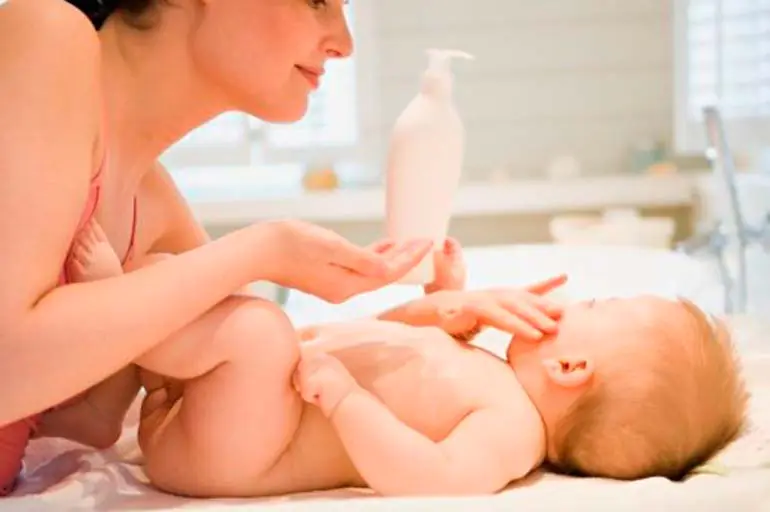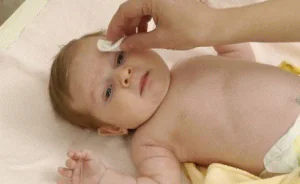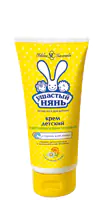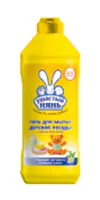Whatever aspect you touch on, you can always say about newborns that they are not a smaller copy of an adult, which means that their body functions according to its own laws. This even applies to the skin. The skin of a newborn baby has its own characteristics, which sometimes cause anxiety in young parents. The baby's skin is delicate and prone to irritation, so it requires special attention. In order to avoid problems and inflammatory processes, it is necessary to carefully care for it. When a child has clean skin, no diaper rash, no rashes, the newborn feels comfortable, sleeps well, does not worry and is not capricious.

Skin Features
When the baby is born, its skin is covered with a layer of cheese-like lubricant. This lubricant acts as a barrier, because in the mother’s tummy the baby was surrounded by amniotic fluid. In the old days, this lubricant was washed off immediately after birth, but now it is believed that it should be absorbed into the skin.
When the issue with lubrication on the skin is leveled out, the mother may notice that the baby’s skin is too red. This is completely normal. Firstly, In the blood of a newborn baby, red blood cells are contained in increased quantities. Secondly, The layer of subcutaneous fat in the baby is still very poorly developed, which means that the blood vessels are very close to the skin and are clearly visible. In addition to the red tint, a vascular pattern may simply appear on the skin.
Poor development of the subcutaneous fat layer “rewards” the baby’s skin with another feature. Newborn babies easily become hypothermic and freeze. At the same time, a “marble” pattern appears on the skin.

All mothers note that the skin of a newborn baby is very soft and velvety to the touch. The infant fluff of lanugo, which covers the shoulders, back, and sometimes the baby’s hips, gives the skin a special velvety quality. However, already on the 2-3rd day of life, the baby’s skin becomes dry and begins to peel off. Thus, adaptation of the skin to the air environment after the water environment is manifested. The functioning of the sebaceous glands has not yet been established, so the skin is deprived of a protective lipid film that helps retain moisture. Most often, the skin of the extremities peels: palms and heels.
You can often notice various rashes on the skin of a newborn. Small white dots that resemble pimples are milia, sebaceous cysts. They are completely safe, appear in the process of establishing the functioning of the sebaceous glands and disappear without a trace without any intervention. Red, inflamed pimples, sometimes called “blooms,” are the result of hormonal changes. After physical separation from the mother’s body, the baby’s body begins to produce its own hormones, which naturally affects the external condition of the skin.
It turns out that most anxiety symptoms are completely normal for a newborn baby. The older your toddler gets, the more his skin becomes similar to the skin of an adult, both in appearance and in the way it functions.
Skin care rules
- To avoid damaging the baby’s delicate skin, an adult’s nails should be cut short and filed;
- If an adult has any sores on his hands (eg boils, nail fungus, sore hangnails), then it is better to entrust the care of the child to a healthy person;
- It is not recommended to overuse hygiene products: use baby soap without allergenic fragrances, use water-based baby cream (see what creams are there);
- Use only high-quality children's cosmetics.
We recommend: Video guide. After childbirth. Caring for a newborn:
Every morning, after the baby wakes up, he must be washed with boiled water.
It is more convenient to carry out morning care on the changing table, since the necessary items will be stably placed on it. The water temperature in the first days is 36-37⁰C, gradually it can be reduced and brought to room temperature (25⁰C). 
- We start by treating the eyes: using a cotton ball soaked in boiled water, wipe the eye with smooth movements without pressure from the outer corner to the inner one. For each eye we use an individual cotton ball.
- Wipe the outside of the nose with a damp cotton ball. The inside of the nostrils is cleaned with a cotton swab, making rotational movements. The flagellum is pre-moistened with boiled water.
- We treat the ears with a cotton wool flagellum, removing wax from the skin of the external auditory canal. It is not worth pushing the flagellum deeper, since the wax is not removed, but is pushed inside the ear canal. It is enough to clean your ears 2 times a week.
- Wipe the face and behind the ears with a cotton ball.
- The umbilical wound should be treated 2 times a day with a 3% solution of hydrogen peroxide, then with brilliant green (details about correct processing).
- After each bowel movement, the baby must be washed with warm running water.
Video:
A baby up to 6 months old needs to be bathed daily and washed after each bowel movement. In addition, the baby needs to have air baths, which will help not only harden the child, but also avoid diaper rash, prickly heat and other skin problems. See article on daily care —
Common truths:

Bathing the child until the umbilical wound heals is carried out in boiled water with the addition of a solution of potassium permanganate. The water should be heated to body temperature or slightly higher (36-37⁰C). Soap cannot be used every day; it is enough to wash the head 2-3 times a week. Decoctions of various herbs can be periodically added to the water. After each bathing, the umbilical wound is treated until it heals. How to bathe a child correctly.- Washing the baby is carried out under running water. The child lies on the mother's arm with his tummy up. The head is placed on the elbow of the mother’s arm, the buttock is on the palm, and the baby’s leg must be secured with the thumb near the hip joint. All movements are directed from the genitals to the gluteal fold. If the child pooped, then use soap. This procedure must be carried out after each bowel movement, and after 2-3 urinations. This care will help avoid diaper rash in the groin folds and buttocks.
- Using powder and creams after washing keep the baby's skin dry and protect it from the irritating effects of urine.
- Air baths. The baby is placed on a changing table, completely undressed and given the opportunity to move his arms and legs freely. It is better to increase the duration of the procedure gradually from 1-2 minutes to 5-10 minutes. as the child grows (how to do air baths).
Let's see how to bathe, how to wash, how to care for the umbilical wound, how to do air baths:
Bathing:
Washing:
Treatment of the umbilical wound:
Air baths:
After you have bathed your child, apply baby cream to the perineum and groin folds. Because The creams contain castor oil, glycerin, and beeswax, which softens and nourishes the skin, and also protects it from all kinds of microbes. Immediately after bathing, it is necessary to treat the baby's skin with cosmetic oil for newborns, lotion or powder.

Most often, parents are frightened by the appearance of crusts on the scalp of the baby (seborrheic crusts). This is not a disease, it is easy to fight. Before each bathing, the crusts are lubricated with petroleum jelly or baby cream, and during bathing they are wiped with a sterile gauze cloth. Movements should be light without pressure, strong friction will lead to the appearance of wounds. (We read about crusts on the head)
- Prickly heat. If there is prickly heat on the child’s body, then you simply need to prevent overheating, avoiding overly warm clothes. At an early stage, normal hygiene for a newborn baby is quite enough. While bathing, you can add chamomile infusion or a decoction of oak bark to the water - More about prickly heat (about treatment);
- Diaper rash. When diaper rash occurs, special attention is paid to skin care after each trip to the toilet. Let the baby’s skin “breathe” more often (the same air baths that were described above), diapers and diapers must be changed every few hours. After changing diapers, the child must be washed with running water, or, in extreme cases, wiped with baby sanitary napkins - More about diaper rash;
- Proper hygiene from the start! We read a large article about organizing proper hygiene for a child from birth.
We also read:
Watch the video:
Webinar on the topic:
Hello girls! Today I will tell you how I managed to get in shape, lose 20 kilograms, and finally get rid of the terrible complexes of fat people. I hope you find the information useful!
Do you want to be the first to read our materials? Subscribe to our telegram channel
Important rules for caring for baby's skin
It is very important to properly care for your child’s skin from early childhood. After all, it is at this time that the foundation of her health and beauty is laid for life.
Children's skin is several times thinner than the skin of an adult; it is finally formed only by the age of 12. The skin of babies contains a large percentage of water, it has almost no acidic protective layer of its own, and it is still difficult for it to independently resist external influences: harmful bacteria, infections and other irritants. Therefore, delicate, sensitive and capricious skin requires increased attention and care. Any friction - washcloth, diaper, diaper - can cause irritation. Clothing containing artificial fibers can also cause itching, prickly heat and cause discomfort to the baby.
Skin matures over the years, but while your baby is growing and developing, it needs special care, and therefore special products designed to take into account the differences in children's skin. Remember, healthy skin for a baby is not only a feeling of comfort, but also the main barrier to the penetration of germs.
There are several important rules for caring for your baby's skin:
1. Change disposable diapers correctly.
Disposable diapers have revolutionized baby care. Mountains of wet diapers are a thing of the past. But to ensure real comfort for your baby, you need to take care of your skin. She is especially susceptible to irritation and redness under a diaper. Even if the diapers are of very good quality, wearing one diaper during the day should not exceed 3 hours. But at night, if the child sleeps peacefully, this time can be extended to 8-10 hours.
You should not put a new diaper on your child immediately after removing the old one. The child needs to take an air bath for 10-15 minutes, and the skin should be dry.
Before each diaper change, the baby must be washed under warm running water, and the girl should be washed from front to back to avoid infection. This can be done using baby cream soap.
If it is not possible to wash your child, use cleansing wet wipes. And if your baby has skin prone to dryness, your first assistant is the “Eared Nyan” cleansing cream wipes.
Before putting on a diaper, it is necessary, in order to avoid diaper rash and irritation, to treat the baby’s bottom and groin area with a special baby protective cream for diapers.
2. Don't forget to nourish and moisturize baby's skin.
Due to the weak function of the sebaceous glands, the surface of the baby’s skin is drier than that of adults, and therefore needs additional nutrition and hydration. Light moisturizing creams are quickly absorbed without leaving an oily sheen, maintaining the natural moisture of the skin and softening it. These creams can be used throughout the day to make your baby's skin soft and smooth. But it is especially necessary to use them to replenish moisture loss after taking water procedures, as well as during the hot season.
Nourishing creams are designed to protect and nourish the skin of babies. They are based on mineral and natural oils. Mineral oil remains on the surface of the skin, covering it with a thin film and thus providing protection. Natural - penetrates deep into the skin, providing an additional caring effect (nutrition, moisturizing, softening, etc.).

Easily vulnerable children's skin is prone to inflammation and redness. To restore the skin and provide protection, use children's anti-inflammatory cream "Eared Nannies". It promotes rapid healing and regeneration of the skin thanks to the optimal combination of mineral and natural oils.
Carefully monitor the condition of your baby's skin, prevent the occurrence of irritation and inflammation. If they are not prevented, serious consequences can occur. Remember that a child’s skin is an indicator of his internal state: if the body does not accept something from food, then a skin reaction (redness, pimples) will immediately tell you that it is better not to introduce this component into the diet. In the same way, allergic reactions occur to a variety of things: dust, pollen, animal hair, and a possible reaction to unsuitable cosmetics.
Pay special attention to protecting baby's skin from wind and sun.
3. Remember, cleanliness is the key to health.
Most children enjoy bathing; warm water calms them down and helps them fall asleep. Children should be bathed at the same time every day; best before feeding. Do not bathe your baby if he has a fever or has pustular skin diseases (dermatologists do not recommend water procedures in such cases).
Wash the bath thoroughly before use, then pour water into it. The air temperature in the bathing room should be 22-24C. The optimal water temperature is 36-37C. You can add medicinal substances to the water (starch for eczema, sea salt for rickets, pine extract for functional disorders of the nervous system, chamomile or calendula for allergic dermatitis) or special children's bubble bath.
It is very important to immerse your baby in the bath correctly. With your left hand you need to grasp the child’s left armpit, the back of the head and head in this case rest on your shoulder; We support the baby from below with our right hand. After immersion in water, be sure to support the child’s head and torso with your left hand and forearm. The water level should not cover the upper chest. The duration of bathing ranges from 3 to 15 minutes. Using your right hand, use gentle circular movements to alternately soap the baby’s head, neck, armpits, arms, chest, belly and legs, and rinse the soaped areas immediately. For washing, use a special children's gel. At the end of washing, the child must be rinsed with clean water. While rinsing, cover his head with your hand to prevent water from getting into his eyes.
When washing your child's hair, pay attention to the condition of the scalp. If you notice crusts of milk scab, be sure to remove them. To do this, 2 hours before the evening bath, thickly lubricate the baby's head with baby oil, and when the crusts soften, remove them using a fine-toothed comb. After this, wash your baby's hair with baby shampoo.
To simplify the procedure of washing your baby, you can use a universal bathing product from head to toe. It performs 2 functions at once - it cleanses both the body and the head well. In the complex of baby hygiene, caring for the nose, ears and nails plays an important role. To regularly clean the nose, use a tightly rolled cotton wool moistened with baby oil. Using gentle rotating movements, insert it into the nasal passage to a depth of 1.5-2 cm and remove accumulated secretions from the nose. If there is too much mucus, use a nasal aspirator.
Your baby's ears should be cleaned after bathing. To do this, it is better to use cotton swabs with a limiter. In this case, only the auricle should be cleaned, without going deeper into the ear canal.
Don't forget about your baby's nails. Be prepared for the fact that in children they grow very quickly and require regular haircuts. Use small scissors for this. It is better if they have blunt ends. Some people find it convenient to use baby nail clippers. It is more convenient to cut nails when the baby is sleeping, but be careful. To avoid touching the skin, squeeze the pads of your fingers.
4. Choose the right children's cosmetics (soap, shampoo, cream, etc.).
The acidity of the skin of babies is different from the acidity of the skin of adults, so adult cosmetics are not suitable for children.
For example, when choosing shampoo for your baby, remember that the fluff that replaces newborn hair in the first months of life, and the hairs that replace it, are much thinner and weaker than the hair of an adult. And the emerging top layer of the scalp is still very tender and vulnerable. Therefore, baby shampoo should be pH-neutral, it should not wash away the natural protective layer, not dry out the skin, rinse off well and not irritate the mucous membrane of the eyes.
Also note that not all products intended for children can be used on newborns. A baby's skin is very thin and sensitive, so to care for it it is better to use creams and cleansers designed specifically for newborns.
In addition to tactile sensations, smells have a great influence on the child. Harsh synthetic perfumes irritate babies. They are more accustomed to natural, subtle aromas.
When using a new brand of soap, shampoo, or cream for the first time, try them on a small area of your body. If redness appears in the area after a while, do not use these cosmetics.
5. Pay special attention to caring for your baby’s clothes and linen.

Since the skin of babies is very delicate and sensitive to external irritants, special attention should be paid to children's clothing and dishes. In the first months of life, babies still have a very imperfect immune system, and with improper care there is a high risk of allergic reactions even in an initially healthy child, so it is better to take care of the baby’s health and work a little.
You should start with what the baby is in constant contact with - clothes and dishes. Both get dirty quickly and often. And it cannot always be returned to its original state simply by thoroughly rinsing in hot water. But you cannot use ordinary detergents, since they all have a complex chemical composition, the components of which are aggressive and can provoke allergic reactions. Until now, many parents continue to believe that it is better to wash children's clothes with baby soap. But still, this is far from the best way to remove various contaminants. And mom doesn’t always have an extra hour and a half to hand wash the accumulated children’s clothes.
Modern developments by detergent manufacturers allow mothers to save time and effort on washing without risking the child’s health. In addition, basic washing rules must be followed.
- Children's clothes must be washed separately from their parents' clothes.
- Underwear for babies up to three months must be washed at a temperature of 90ºC, which replaces boiling.
- Children's underwear needs to be rinsed twice as thoroughly.
- For washing, you must use only special children's products: washing powders, conditioners, stain removers.
- It is important to follow the instructions on the packaging.
And it’s best if these are products from the “Eared Nannies” series. After all, they all passed special tests, and this is proof of their hypoallergenicity. All of them are designed for washing newborn clothes. The "Eared Nanny" washing powder does not contain soap, so it is easy to completely rinse out of the fabric, which eliminates the occurrence of allergic reactions. Air conditioners "Eared Nannies" give clothes softness, facilitate the ironing process, and remove static electricity. The "Eared Nanny" stain remover is especially effective at removing stains from fruits, tea, grass, chocolate, oil and specific children's stains.
Do not forget.
- Apply moisturizer to particularly dry areas of the skin at least twice a day.
- Carefully examine the area behind the ears and folds of skin (elbows, knees, groins): there may be redness or peeling.
- Every time you change a diaper, protect your skin with a special diaper cream.
- Carefully choose children's cosmetics, paying attention to the manufacturer, the composition of the cosmetic product, and the expiration date.
- Use only products that are intended for children and have been dermatologically tested.
Based on materials from the Nevskaya Cosmetics website
It's no secret that every age is completely special. This also applies to the skin. Like everything else in our body, it changes over time and requires a special approach. This is why a 25-year-old girl will not take a product intended for women aged 50+ off the shelf in a cosmetic store. The same goes for children and teenagers. The skin of a child in the pre-adolescent period has its own characteristics. It is no longer as fragile and vulnerable as a baby’s, but not yet as fat as a teenager’s.
The first hormonal changes that affect the state of the epidermis occur at approximately 10 years of age. This is an important period, because at this age the child is already independent enough to carry out hygiene procedures consciously. So your task is not to miss the opportunity and instill in your baby basic (and most important!) skin care skills.
Children's skin is sensitive - no wonder it needs special care
Baby skin care
- Cleansing. You need to wash your face twice a day. The morning procedure should be carried out with cool water. A good option is to use ice cubes. They can be made from pure water, green tea or a decoction of herbs - for example, chamomile. If you buy all this in bags, the child will be able to make ice for himself - this is both useful and interesting. After a long day, the skin needs a more serious procedure: the long day is over, the child ran, played, went outside, and now the sweat and dust need to be washed off the face. All these contaminants will be removed by gel or foam. You can also use cream soap. The most important thing is that the cosmetics are specifically for children. Even the most gentle mother's cleanser will be too active for the baby and can harm his skin.
- Creams. There should be three of them in the baby’s arsenal, depending on what tasks the device has to solve. The first one is universal. Its task is to maintain the natural level of moisture in the child’s skin. You should use this cream in the evening after washing your face, as well as in the fall and spring when going outside. The second is for summer, with sun protection factor. It will protect your baby's skin from ultraviolet radiation. The third is weather cream. Protection against peeling and chapping is precisely its task. When purchasing, carefully read the information on the tube. If there are two creams on the shelf, one of which is enriched with SPF, give preference to it.
- Nutrition. At this age, you can explain to your baby that his diet directly affects his skin. Monitor your child’s diet and try to exclude fried foods, smoked foods, snacks, chips, soda and sweets. But porridge, vegetables, meat and fish, prepared in a gentle way, as well as clean water and fruits, on the contrary, will help the baby to be beautiful.
- The first decorative cosmetics. At this age, girls are actively interested in the contents of their mother’s cosmetic bags. Often - to my mother’s delight. You are in vain to rejoice: just like skincare cosmetics, “adult” makeup products are not suitable for children’s skin and will most likely cause harm. Do not allow your baby to use your own decorative cosmetics. Let her have her own children's hygienic lipstick (by the way, it will not hurt a boy either), and for special occasions - her own cosmetics and perfumes. All these products must be hypoallergenic and designed specifically for children. You can, of course, ignore this requirement and allow the girl to use her own powder and mascara. But think about it: will she be grateful to you if she then struggles with the consequences of allergies all her life?
Teen skin care
During adolescence, the body faces a hormonal storm. Everything changes in a child’s life: his psyche, body and, of course, appearance. First of all, the skin. It becomes greasy, shiny, inflamed elements, pimples and acne appear. All these “side effects” of growing up need to be dealt with correctly. And the most important thing is to do no harm.
A teenager should use only special means. Cosmetics for oily or problem skin of adults are not suitable for him, because the reasons for this oiliness are completely different! It is best to consult with a cosmetologist and dermatologist and choose skin care tactics together with him. In this case, you will definitely be sure that your actions are correct. In general, the rules for caring for teenage skin are as follows.
- Cleansing. The dirt and sebum remover should be chosen according to your skin type. You should wash your face at least twice a day: morning and evening. But if the day is hot or there is a sports activity coming up, you will have to grab a bottle of “wash.” As an option, special napkins are suitable. The main thing is to prevent the mixture of dirt and grease particles from remaining on your face. This will lead to the activation of microorganisms, and the number of skin rashes will increase. Girls should definitely get a makeup remover and not neglect it under any circumstances. Along with the bottle of remover, you should also buy a pack of makeup remover wipes - they will come in handy on special occasions.
- Moisturizing and nutrition. Many limit themselves only to cleansing and, perhaps, toning products. And they make a huge mistake! Any skin needs cleansing, toning, and moisturizing. Aggressive removal of sebum (and this is what teenagers usually strive for) leads to activation of the sebaceous glands - after all, they strive to protect the epidermis, which only makes the problem worse. Therefore, you will also need a moisturizer that suits your skin type.
- Protection. In the summer, when the sun is especially active, you should use creams with SPF. Firstly, it will prevent premature skin aging. Secondly, under the influence of ultraviolet radiation, the sebaceous glands increase the production of oil, which means that there will also be more acne manifestations.
In addition to daily manipulations, the teenage skin care program should also include periodic ones (those that are carried out once a week or two). This means cleansing the skin with scrubs and using masks. The first rule is not to overdo it. Use these products at the frequency recommended by the manufacturer. You should not do this every day: your skin will react to aggressive care with increased sebum secretion.
The second rule is to use all scrubs and gommages only when there are no active rashes on the face. Pustules and pimples are a direct contraindication! Inflammatory elements, of course, can be removed - but only from the surface and only for a while. In fact, you will be doing your skin a disservice. Particles of the contents, along with lymph, will spread throughout the face, and soon a new wave of “surprises” awaits you. So in the active phase - only masks, soft products and salon procedures.
Almost all teenagers have encountered this disease. Only the lucky ones who inherited perfect skin from their parents managed to avoid this. The period of active acne requires an extremely gentle and attentive attitude to the skin. The main thing is to create conditions under which the risk of new inflammations would be minimal.
If acne bothers you, avoid makeup entirely.
Refrain from using decorative cosmetics and thick creams, do not touch your face with your hands, remove bangs from your forehead, wash your face with cool water and avoid hot baths. Clothing, bed linen and towels must be perfectly clean. To avoid putting your face at risk, after washing, do not wipe it, but let it dry, or pat your skin dry with paper towels. Cosmetic cleaning in the salon is also acceptable.
All products that cover the skin with a thick layer (for example, foundation or powder) cause it to produce more sebum. If this happens in the summer, in the heat, the situation only gets worse. But it’s not so easy to do without makeup at all! The best solution is good cosmetics. It should be hypoallergenic and antibacterial.
A good option is mineral products. They are made from natural ingredients and, when it comes to powder products, are very finely ground. Mineral powder covers the face with a thin layer through which the skin breathes. And at the same time, such a product successfully masks unevenness, evens out the color - in a word, it does everything that powder should do.
Take a closer look at mineral cosmetics - they are good for teenage skin
In the lines of mineral products there are very useful products like kaolin powder, which absorbs excess oil and dries out the skin, and veils with an anti-shine effect. Another advantage of such cosmetics is that its natural composition heals the skin. Many girls note that after a month or two of constant use of mineral water, the rashes become smaller, and in general the face looks healthier.
This factor is one of the decisive ones in skin care. To prevent your face from becoming oily and breaking out in rashes, you will have to give up fast food, salty, spicy, fatty, fried and very hot foods, as well as sweets and soda. A healthy menu with plenty of whole grains, meat and fish, fresh vegetables and fruits will quickly transform your skin. Special attention should be paid to the health of internal organs. If there are problems with the pancreas or gall bladder, they should be eliminated.
All of these measures taken together will help you overcome adolescence with minimal losses and preserve the beauty of your skin. Of course it takes some effort. But hardly anything can compare with clear, glowing skin. Be patient a little, and all your life you will be proud of your own willpower and reflection in the mirror!



